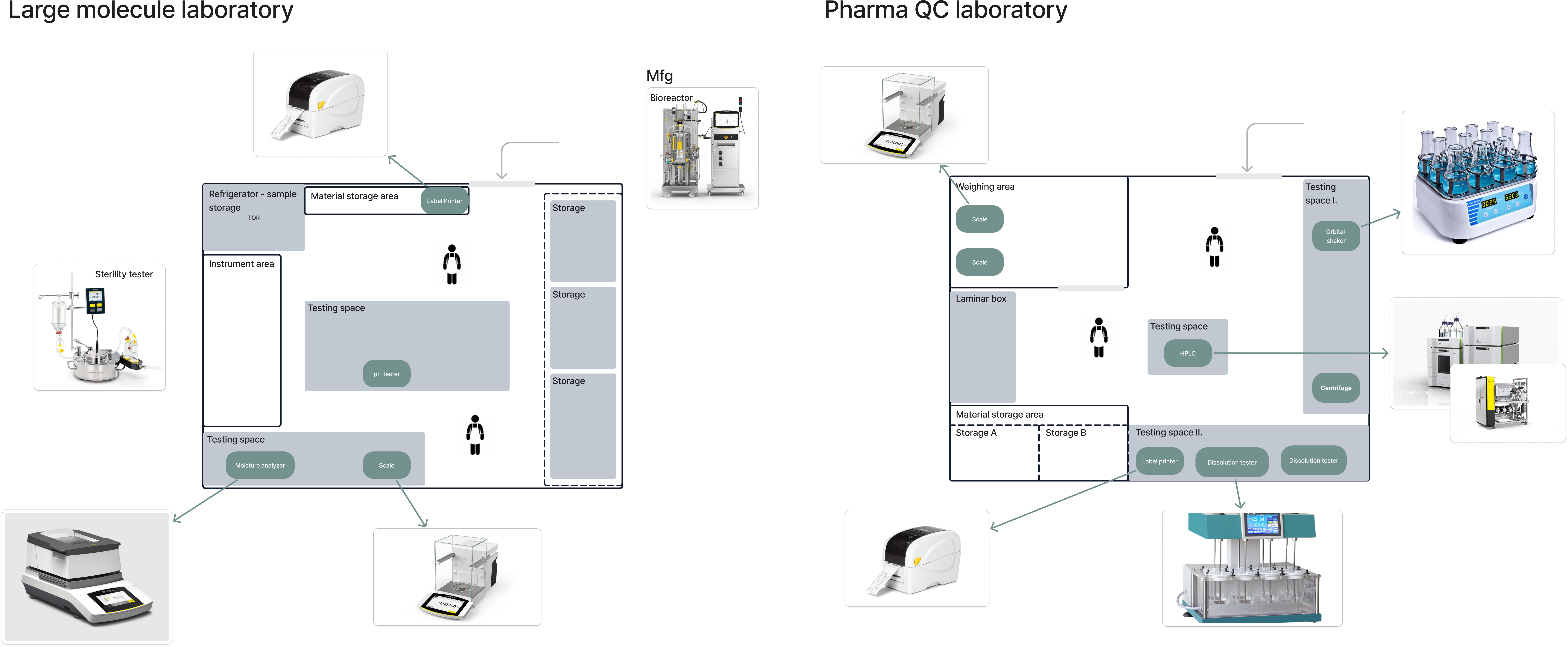Pakiet aplikacji do operacji laboratoryjnych obejmuje różne przypadki użycia w celu usprawnienia zarządzania laboratorium. Te przypadki użycia obejmują zarządzanie próbkami, zarządzanie zapasami i zdigitalizowane instrukcje pracy dotyczące procedur pobierania próbek. Pakiet aplikacji jest podzielony na trzy grupy: Laboratory Management, Instrument management i Sample Procedures. Niniejszy artykuł ma na celu przedstawienie przeglądu pakietu aplikacji. Szczegółowy opis poszczególnych aplikacji można znaleźć w artykułach dotyczących grup aplikacji.
Zakres fizyczny
Przykłady:

Pakiet aplikacji został zaprojektowany tak, aby zaspokoić potrzeby wielu typów laboratoriów, takich jak laboratorium kontroli jakości produktów farmaceutycznych, laboratorium dużych cząsteczek lub laboratorium badawczo-rozwojowe. Jak pokazano w dwóch przykładach, niektóre z aplikacji w tym pakiecie aplikacji są przeznaczone do użytku w różnych środowiskach laboratoryjnych (np. zarządzanie zapasami lub zarządzanie instrumentami), podczas gdy inne aplikacje są dla siebie alternatywą. Do zarządzania próbkami i nawigacji po procedurach pobierania próbek pakiet zawiera 2-2 aplikacje. Aby pomóc użytkownikom w wyborze aplikacji, przeczytaj artykuł Opcje zarządzania próbkami.
Tabele używane w grupie aplikacji
Próbki: Ta tabela służy do przechowywania próbek. Przed otrzymaniem próbki w laboratorium jej status jest ustawiony na "WYMAGANA". Po otrzymaniu próbki jej status można zmienić na "RECEIVED" lub "PROCEDURE DEFINED", jeśli procedury dla próbki zostały dodane ręcznie. Gdy status próbki zostanie zmieniony na "PROCEDURA ZAKOŃCZONA", użytkownik pracujący w aplikacji do zarządzania próbkami może zatwierdzić lub odrzucić próbkę, aktualizując jej status odpowiednio do "ZATWIERDZONA" lub "ODRZUCONA".
Zadania: Ta tabela przechowuje przykładowe procedury, które mogą mieć statusy "OCZEKUJĄCE", "W TRAKCIE REALIZACJI" i "ZREALIZOWANE" w miarę postępów w realizacji zadania.
Plany próbkowania: Ta tabela służy do przechowywania planów pobierania próbek. Każdy rekord reprezentuje procedurę wymaganą dla danej próbki, identyfikowaną przez pole "Sample Reference". Aplikacja Sampling Plan Management może wypełnić tabelę; w przeciwnym razie służy ona jako tabela referencyjna na co dzień. Oznacza to, że Tulip Automation pobiera listę próbek i procedur pobierania próbek z tabeli Plany pobierania próbek do tabel Próbki i Zadania.
Wyniki inspekcji: Jeśli procedura próbkowania jest inspekcją, jej wynikiem jest często wynik inspekcji. Po zakończeniu zadania wynik może zostać zarejestrowany w tabeli Inspection Results.
Specyfikacje produktu: Ta tabela zawiera dolne i górne limity dla wszystkich wymaganych kontroli według identyfikatorów produktów i procedur. Gdy wyniki kontroli są rejestrowane, pole Pass/Fail może zostać wypełnione przez porównanie zmierzonej wartości z tymi limitami.
Materiały: Tabela materiałów przechowuje wszystkie pozycje inwentarza niebędące próbkami, które są używane w laboratorium. Każdy rekord odnosi się do fizycznego elementu. Tabela ta służy do śledzenia lokalizacji materiału oraz jego ilości.
Definicje materiałów: Każdy rekord w tej tabeli odnosi się do materiału lub typu produktu. Zawiera główne informacje o typie materiału, takie jak informacje GHS lub wymagane warunki przechowywania materiału.
:::(Info)If you'd like to learn more about Tulip's Common Data Model (CDM)
for Pharma, check out this link.
:::
Pakiet aplikacji Laboratory Operations obejmuje następujące grupy aplikacji:
Grupa aplikacji Laboratory Management
Grupa aplikacji Laboratory Management usprawnia podstawowe przepływy pracy laboratoryjnej w środowiskach takich jak Pharma QC i laboratoria dużych cząsteczek. Obsługuje wydajne śledzenie próbek, kontrolę zapasów i nadzór operacyjny, umożliwiając laboratoriom utrzymanie zgodności i poprawę wydajności.
Grupa aplikacji Instrument Management
Grupa aplikacji Instrument Management usprawnia zarządzanie i obsługę instrumentów laboratoryjnych. Obejmuje ona aplikację Instrument Manager do monitorowania stanu przyrządów, dodawania nowych przyrządów i uzyskiwania dostępu do procedur, a także przykładową aplikację do kalibracji pH-metru demonstrującą procedurę specyficzną dla przyrządu.
Grupa aplikacji Procedury próbek
Grupa aplikacji Sample Procedures w ramach pakietu aplikacji Laboratory Operations zapewnia narzędzia do zarządzania przepływami pracy związanymi z próbkami i nawigacji do określonych procedur dotyczących próbek.
Łączenie z aplikacjami i pakietami aplikacji
Pakiet aplikacji Laboratory Operations łączy się bezpośrednio z pakietem aplikacjiComposable MES for Pharma i innymi rozwiązaniami Tulip, wykorzystując Common Data Model do spójnej wymiany danych i integracji między systemami laboratoryjnymi.Composable MES for Pharmaceutical Manufacturing
